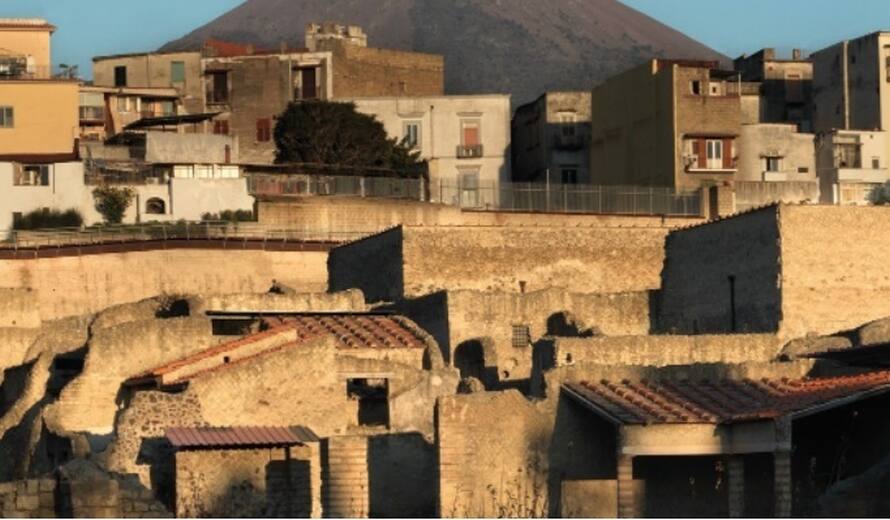Report outlines ways to improve community engagement through visitor centres at UNESCO designated sites
The report on the third regional workshop for Europe on “The Role of Visitor Centres in UNESCO Designated Sites,” held between 23 September and 2 October 2021, has been released. During online and in-presence activities, held in Ercolano, Italy, participants explored the role of visitor centres through a sustainable development lens and reflected on their potential as a catalyst for community engagement and more inclusive forms of heritage-led development in UNESCO designated sites.
Rather than being a typical response to tourism trends, with the sole purpose of orientating visitors during the site experience, visitor centres in UNESCO designated sites will be revisited and understood as vehicles to build bridges between site authorities and local communities and between the latter category and tourists.
This includes the definition of new forms and processes that extend the scope of action of the centres beyond the confines of the core heritage protected areas, in a way to better integrate sites within their broader social, environmental and economic territorial contexts, and to maximise their capacity for sustainable development.
The conservation and management of the Herculaneum Archaeological Park and its surroundings proved an apt real-life case study for the workshop, which enabled the participants to reflect on various challenges and opportunities related to managing such a rich and diverse territory. The workshop was organised by the UNESCO Regional Bureau for Science and Culture in Europe in partnership with the Herculaneum Archaeological Park and the Herculaneum Conservation Project, in collaboration with the City of Ercolano, Herculaneum Virtual Archaeological Museum - MAV, Ente Ville Vesuviane Foundation, Cooperativa Sociale Giancarlo Siani, Pompeii Archaeological Park, Vesuvius National Park, Department of Agricultural Studies of University Federico II Napoli and Centro MUSA.
Participants, selected through a call for applications, included representatives of 19 designated sites from 15 UNESCO Member States, which included 16 World Heritage properties, 4 Global Geoparks and 1 Biosphere Reserves with 2 multi-designated sites.
'Discussions during the workshop were especially inspired by the positive experience of the public-private partnership developed between the Herculaneum Archaeological Park and the Herculaneum Conservation Project, and evolved around how this experience could be sustained and possibly extended to generate broader partnerships on a territorial scale.'
Matteo Rosati, Officer in charge, Culture unit, UNESCO Regional Bureau
Conclusions emerging from the exchange among participants, as presented in the last chapter of the report, include general considerations regarding the evolution of “visitor centres” which can be applicable to a broad range of heritage sites and protected areas, including but not limited to UNESCO designated sites.
Participants widely agreed that site visitor centres should include community engagement as an integral part of their mission and develop community-oriented services as part of their core business. Community engagement should be rooted in the governance of visitor centre facilities, in line with the increasing recognition of inclusive and participatory models for heritage management. Investments in capacity development to effectively adopt people-centred approaches in heritage management are needed. Facilitating physical and cognitive access for all is key to harnessing the benefits of an improved relationship between communities and their sites. Membership status for local residents, guided visits, free entry to special events and other similar activities promote emotional and daily-life connections that can reinforce ownership and contribute to the wellbeing of both heritage and communities.
'Communication is a key area in which UNESCO designated sites should invest to enhance community engagement. Within this framework, visitor centres can play a critical role by helping community members better understand and appreciate the value of their heritage and protected places.'
Ana Luiza M. Thompson-Flores, Director, UNESCO Regional Bureau
Community narratives should be part of the site interpretation, with the active participation of community members; to this end, capacities within local communities also need to be recognised, developed and harnessed. Co-designed activities can also evolve into more advanced solutions to leverage local insight and creative resources, in line with the spirit of “doing it for the people, with the people.”
An additional workshop is planned in 2022 within the scope of this initiative, focusing on the role of visitor centres in tourism sustainability and visitors’ management.
The organisation of this series of regional workshops and the production of reports are made possible thanks to the annual contribution of Italy to the UNESCO Regional Bureau for Science and Culture in Europe.
Links
- The role of visitor centres in UNESCO designated sites: report of the third regional workshop for Europe (Online, 23 September 2021; Ercolano, Italy, 29 September – 2 October 2021)
- The role of visitor centres in UNESCO designated sites: report of the first regional workshop for Europe, 30 September-2 October 2018, Palermo, Italy
- The role of visitor centres in UNESCO designated sites, 6-8 October 2019, Bamberg, Germany: report of the second regional workshop for Europe
- The impact of COVID-19 on visitor centres in UNESCO designated sites in Europe: a general review, 2021

